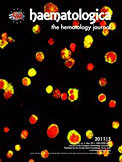Hollink IH, van den Heuvel-Eibrink MM, Arentsen-Peters ST, Zimmermann M, Peeters JK, Valk PJ, Balgobind BV, Sonneveld E, Kaspers GJ, de Bont ES, Trka J, Baruchel A, Creutzig U, Pieters R, Reinhardt D, Zwaan CM. Haematologica. 2011 Mar;96(3):384–92. Epub 2010 Dec 6. IF: 6.416

Abstract:
BACKGROUND: Dysfunctioning of CCAAT/enhancer binding protein α (C/EBPα) in acute myeloid leukemia can be caused, amongst others, by mutations in the encoding gene (CEBPA) and bypromoter hypermethylation. CEBPA-mutated acute myeloid leukemia is associated with a favorable outcome, but this may be restricted to the case of double mutations in CEBPA in adult acutemyeloid leukemia. In pediatric acute myeloid leukemia, data on the impact of these mutations are limited to one series, and data on promoter hypermethylation are lacking. Our objective was to investigate the characteristics, gene expression profiles and prognostic impact of the different CEBPA aberrations in pediatric acute myeloid leukemia. DESIGN AND METHODS: We screened a large pediatric cohort (n = 252) for CEBPA single and double mutations by direct sequencing, and for promoter hypermethylation by methylation-specific polymerase chain reaction. Furthermore, we determined the gene-expression profiles (Affymetrix HGU133 plus 2.0 arrays) of this cohort (n = 237). RESULTS: Thirty-four mutations were identified in 20 out of the 252 cases (7.9 %), including 14 double-mutant and 6 single-mutant cases. CEBPA double mutations conferred a significantly better 5-year overall survival compared with single mutations (79 % versus 25 %, respectively; P = 0.04), and compared with CEBPA wild-type acute myeloid leukemia excluding core-binding factor cases (47 %; P = 0.07). Multivariate analysis confirmed that the double mutations were an independent favorable prognostic factor for survival (hazard ratio 0.23, P = 0.04). The combination of screening forpromoter hypermethylation and gene expression profiling identified five patients with silenced CEBPA, of whom four cases relapsed. All cases characteristically expressed T-lymphoid markers. Moreover, unsupervised clustering of gene expression profiles showed a clustering of CEBPA double-mutant and silenced cases, pointing towards a common hallmark of abrogated C/EBPα-functioning in these acute myeloid leukemias. CONCLUSIONS: We showed the independent favorable outcome of patients with CEBPA double-mutant acute myeloid leukemia in a large pediatric series. This molecular marker may, therefore, improve risk-group stratification in pediatric acute myeloid leukemia. For the first time, CEBPA-silenced cases are suggested to confer a poor outcome in pediatric acute myeloid leukemia, indicating that further investigation of this aberration is needed. Furthermore, clustering of gene expression profiles provided insight into the biological similarities and diversities of the different aberrations in CEBPA in pediatric acute myeloid leukemia.
-mk-